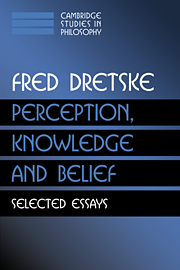Book contents
1 - Conclusive Reasons
Published online by Cambridge University Press: 19 December 2009
Summary
Conclusive reasons have a modal as well as an epistemic character. In having conclusive reasons to believe that P is the case one's epistemic credentials are such as to eliminate the possibility of mistake. This, at least, is how I propose to understand them for the remainder of this essay. Letting the symbol “〈〉” represent the appropriate modality (a yet to be clarified sense of possibility), I shall say, then, that R is a conclusive reason for P if and only if, given R, ∼ 〈〉 ∼ P (or, alternatively, ∼ 〈〉 (R. ∼ P)). This interpretation allows us to say of any subject, S, who believes that P and who has conclusive reasons for believing that P, that, given these reasons, he could not be wrong about P or, given these reasons, it is false that he might be mistaken about P.
Suppose, then, that
S knows that P and he knows this on the basis (simply) of R entails
R would not be the case unless P were the case.
The latter formula expresses a connection between R and P that is strong enough, I submit, to permit us to say that if (2) is true, then R is a conclusive reason for P. For if (2) is true, we are entitled not only to deny that, given R, not-P is the case, but also that, given R, not-P might be the case.
- Type
- Chapter
- Information
- Perception, Knowledge and BeliefSelected Essays, pp. 3 - 29Publisher: Cambridge University PressPrint publication year: 2000
- 4
- Cited by



